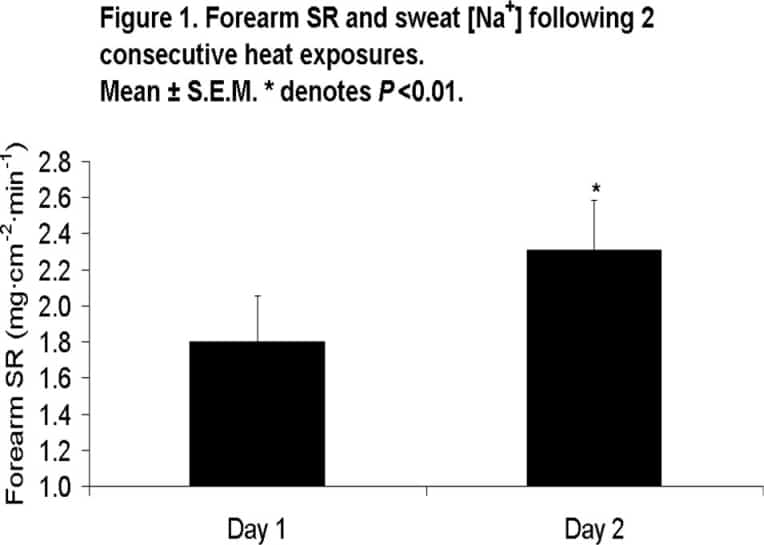Repeated exposure to exercise in the heat has been associated with a reduction in heart rate (HR), rectal temperature (Tre) and skin temperature (Tsk), and an increase in sweat rate (SR) following 56 days (Shvartz et.al. 1973). Sweat composition also adapts, with a reduction in sweat [Na+] found after 4 days (Allsopp et.al. 1998). These adaptations may occur earlier within the acclimation process, hence the present study investigated the effect of a single exercise-heat exposure on these variables.Five male subjects (age 26±7 y, mass 81.727±8.680 kg, peak oxygen uptake (VO2peak) 4.1±0.6 L.min-1, means ± S.D.) completed a familiarisation trial involving a 2 h exercise bout (42±4 % VO2peak) in a hot-humid environment (38 oC, 60 % RH) with no fluid replacement. From this, the volume of fluid required to maintain euhydration during subsequent tests was calculated. Seven days following familiarisation, the experimental trial started, consisting of two exercise heat exposures on consecutive days. The exercise and environmental conditions were those of the familiarisation, except euhydration was maintained. Whole body SR was calculated from changes in body mass and regional sweat was collected at the forearm. Sweat electrolytes were determined with the use of indirect Ion Selective Electrodes and osmolality was determined using freezing-point depression. Tre,Tsk and HR were measured every minute. Blood samples were collected from an indwelling catheter in the antecubital vein and plasma aldosterone was analysed with a commercially available radioimmunoassay kit. Percentage change in plasma volume was estimated using the method of Dill & Costill (1974).Comparison of the two euhydrated days by Student’s paired t-test indicated that whole body SR increased significantly from day 1 (1.07 ±0.05 L.h-1) to day 2 (1.16 ±0.04 L.h-1) (P<0.01) as did the regional SR at the forearm (P<0.01) (Figure 1). There was no change in sweat [Na+] (Figure 1), [K+], [Cl–], osmolality or percentage plasma volume change. Repeated measures ANOVA indicated no change in HR, Tre,Tsk,or plasma aldosterone at rest or after exercise.The present study indicates an increase in SR occurred without a concurrent increase in sweat [Na+] following an acute exercise-heat stress. Since sweat [Na+] is known to increase with increasing SR (Allan & Wilson 1971), our results suggest that the adaptation reflects an increased reabsorption of Na+ in the duct of the sweat gland.
University of Glasgow (2004) J Physiol 557P, C65
Communications: The effect of an acute exercise-heat stress on subsequent human thermoregulatory and sweat variables
H.C. Milne and M.A. Nimmo
Department of Applied Physiology, University of Strathclyde, Glasgow, UK
View other abstracts by:
Where applicable, experiments conform with Society ethical requirements.

